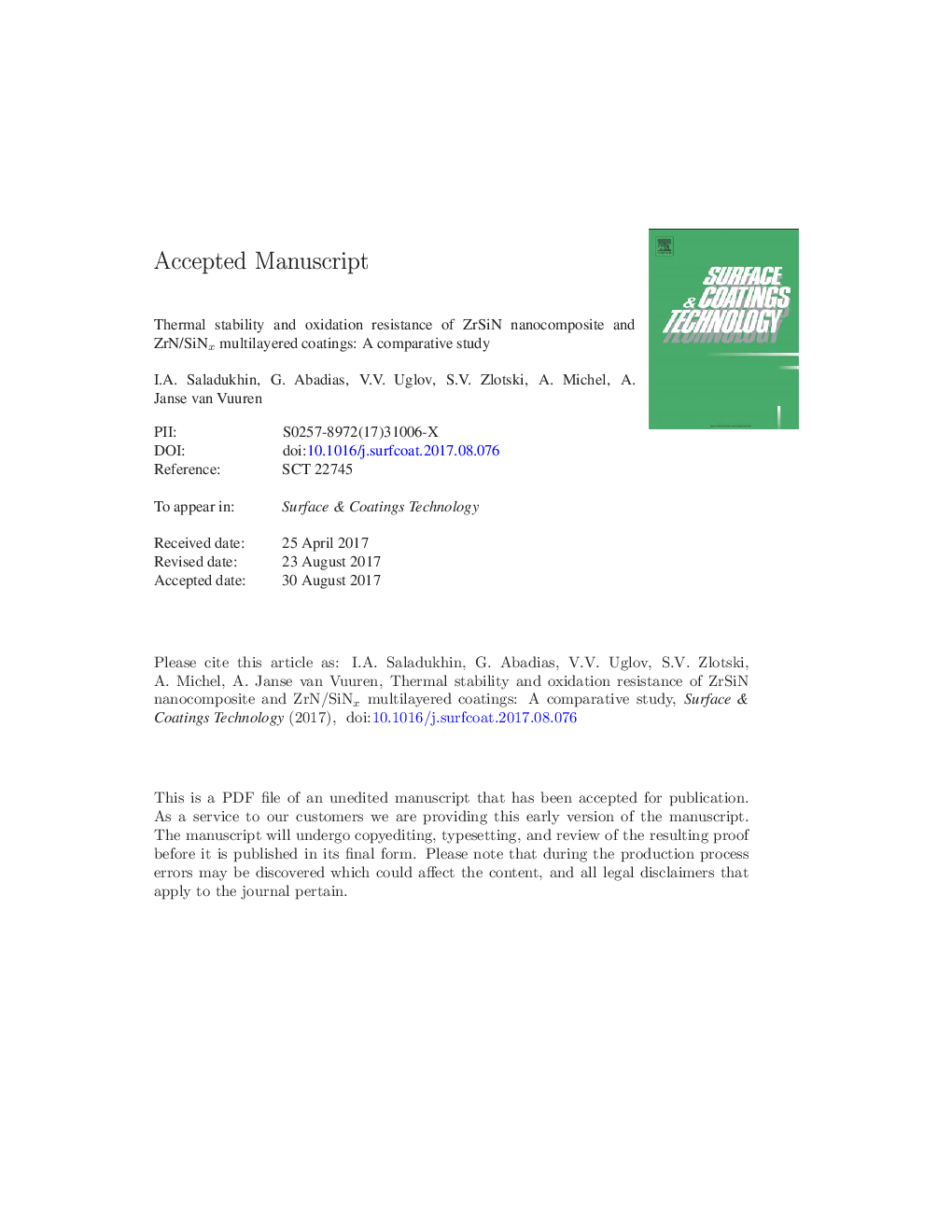| کد مقاله | کد نشریه | سال انتشار | مقاله انگلیسی | نسخه تمام متن |
|---|---|---|---|---|
| 8024776 | 1517551 | 2017 | 45 صفحه PDF | دانلود رایگان |
عنوان انگلیسی مقاله ISI
Thermal stability and oxidation resistance of ZrSiN nanocomposite and ZrN/SiNx multilayered coatings: A comparative study
دانلود مقاله + سفارش ترجمه
دانلود مقاله ISI انگلیسی
رایگان برای ایرانیان
کلمات کلیدی
موضوعات مرتبط
مهندسی و علوم پایه
مهندسی مواد
فناوری نانو (نانو تکنولوژی)
پیش نمایش صفحه اول مقاله

چکیده انگلیسی
In the present work we comparatively study the thermal stability and oxidation resistance of ~ 300 nm thick Zr-Si-N coatings with either 2D or 3D interface geometry: 1) Zr-Si-N nanocomposites and 2) ZrN/SiNx nanoscale multilayers. Both types of films were prepared by reactive magnetron sputter-deposition on Si wafers under Ar + N2 plasma discharges. Zr-Si-N films were deposited by co-sputtering from Zr and Si targets at substrate temperature Tdep of 600 °C, with Si content ranging from 0 to 22.1 at.%, while ZrN/SiNx multilayers with ZrN (resp. SiNx) layer thickness varying from 2 to 40 nm (resp. 0.4 to 20 nm) were synthesized by sequential sputtering from elemental Zr and Si3N4 targets at Tdep = 300 °C. According to transmission electron microscopy (TEM) and X-ray diffraction (XRD) analysis the microstructure of Zr-Si-N films changes from dual-phase nanocomposite structure, consisting of ZrN nanograins (4-7 nm) surrounded by an amorphous tissue, towards X-ray amorphous with increasing Si content. The multilayered films consist of nanocrystalline (002)-oriented ZrN and amorphous SiNx layers. The structural evolution has been investigated by XRD after vacuum annealing at 1000 °C, while the oxidation resistance under air was studied using in situ XRD in the temperature range from 400 to 950 °C, as well as by scanning electron microscopy (SEM) and wavelength dispersive X-ray spectrometry (WDS) after air annealing procedure. While the reference ZrN film starts to oxidize at Tox. = 550 °C, a much higher oxidation resistance is found for multilayered films, till Tox. = 860-950 °C for ZrN/SiNx coatings with the elementary layer thickness ratio of 5 nm/10 nm, 3 nm/5 nm and 2 nm/5 nm. ZrSiN nanocomposites exhibit an improved oxidation resistance with increasing Si content compared to binary ZrN compound, but their stability is worst comparatively to the multilayers case.
ناشر
Database: Elsevier - ScienceDirect (ساینس دایرکت)
Journal: Surface and Coatings Technology - Volume 332, 25 December 2017, Pages 428-439
Journal: Surface and Coatings Technology - Volume 332, 25 December 2017, Pages 428-439
نویسندگان
I.A. Saladukhin, G. Abadias, V.V. Uglov, S.V. Zlotski, A. Michel, A. Janse van Vuuren,